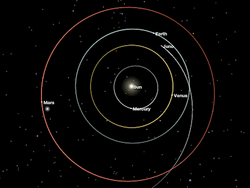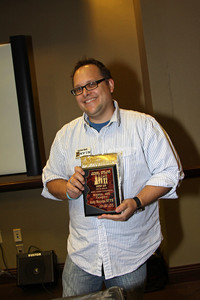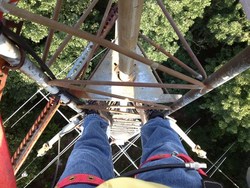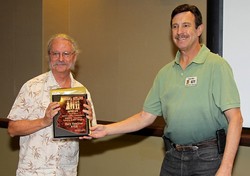 September 11, 2013 Editor: Ward Silver, NØAX | ||||||||
IN THIS ISSUE
NEW HF OPERATORS - THINGS TO DO As the fall equinox approaches, new HF operators should be noticing the improved conditions over the poles. This is a great time to try out the polar paths that have been diminished all summer. To that end, try the Scandinavian Activity Contests (CW - 21 Sep and SSB - Oct 12) and put some OH/LA/SM/OZ contacts in your log! BULLETINS There are no bulletins in this issue. BUSTED QSOS No uproarious pratfalls were reported in the previous issue. CONTEST SUMMARY Complete information for all contests follows the Conversation section Sep 14-15
Sep 21-22
After providing all of us with 14 years of looking up our favorite calls, helping us get new calls, and generally making the vanity-call process a whole lot more fun, Michael N4MC has called it a day and site operations have been terminated. In the future, the RadioQTH service may provide the call sign lookup service that you need. (Thanks, Dick N6AA and the Daily DX)
Yan XV4Y has released version 1.00 of his free online contest log analyzer, QScope.org. The service provides a number of statistics on single logs or groups of logs in ADIF or Cabrillo format. The chart at right shows a typical pie chart breaking down QSOs by band. There are many other statistics available, such as uniques (one-time contacts - the service does not validate calls), CQ and ITU zones worked, QSO rates, maximum rates, QSO points, etc. There is a statistic for every need, it seems. (Thanks, Jim VE7FO and Steve K6AW) The 2013 USA Amateur Radio Direction Finding (ARDF) Championships will be held in North Carolina's Uwharrie Mountains on October 8-13. (No, that's not a way of saying, "You Hurry!" which would be appropriate for a competition, I admit.) ARDF events take place on the 2 meter and 80 meter amateur bands but are open to anyone, since no transmitting takes place. The courses cover 4 to 10 km and there are various age and gender categories making the competition attractive to beginners as well as experienced "DF-ers". WRTC-2014 Co-Chair, Randy K5ZD has broadcase a reminder that all Team Leader applications must be submitted by September 13 - two days from this issue's publication. More than 100 applications have been received. Also, a new rules FAQ page has been posted to answer questions that have been received about the rules for the WRTC2014 competition. Not everyone who qualifies will choose to submit an application. If the top qualifier(s) do not apply, the next eligible qualifier application that has been received will earn the spot. There are also two Wild Card slots that will be selected from the remaining applications after the top qualifiers are selected. You must submit an application to be considered. It's probably safe to say that Scouting introduces Amateur Radio to more young people than any other single youth organization. To that the end, the K2BSA team is doing outstanding service in attempting to get 4,000 Scouts on the air during the current BSA National Jamboree. In addition, they're taking advantage of the event to educate even more Scouts and Scouters across the country about Amateur Radio. They even got the editor of Scouting Magazine (which goes to all 900,000 registered Scout Leaders across the country ) to blog about Foxhunting. (Thanks, Gary K2GW)
Midwest Mania is coming to the "ultra-highs". If you are a VHF/UHF weak-signal op from North Texas northward to southern Manitoba or from the Rockies Front Range eastward to about the Mississippi River, Bruce W9FZ/R urges you to get on for this weekend's September VHF Contest. If you know you'll be on, email Bruce your call, grid, bands, and plans. He'll take what you send and add it to the website. There is also a spreadsheet you can edit yourself and tabs on the website for fixed stations, rovers, and portables. Bruce's goal is to get every possible op on-the-air and turn what can be a sometimes quiet area into a bedlam of activity. From around the web via the Daily DX, we find that Michael G7VJR of ClubLog has ascertained how many DXers there are in the world. Elsewhere in the world of DX, Wayne N7NG has updated his popular booklet "DXpeditioning Basics - 2013", available from the DX University website. With so much overlap between DXpeditions and contest expeditions and contesting, this is a must-read! The Pacific Northwest VHF Conference is coming up on October 12-13 in Moses Lake, WA. You can still take advantage of the early bird rates and the special hotel rate until September 18th. Jukka OH6LI has been getting himself in good physical condition for the upcoming contest season by climbing his tower! "My training program has been to climb minimum 60m (200ft) per day at my home for the past two-three weeks, four or five days a week. I carry the safety harness and some tools with me to increase the power out through proper load setting. I have measured heart rates exceeding 160 before I start to feel I should slow down." Tony K4QE points out that with so much pointing and clicking during the contest, maybe that mouse finger needs a little exercise, too!
Web Site of the Week - Does your 10 meter antenna farm have enough horsepower to say hello to the Juno spacecraft? NASA researchers will be listening for ham signals as Juno rockets past the Earth on Oct 9 on its way to a Jovian rendezvous in 2016. As HF operators well know, due to low solar flux the ionosphere hasn't been reflecting 10 meter signals back to Earth very well. Why not take advantage of that window to space and sign up to contact an interplanetary mission? With humans expected to be traveling to the Moon or beyond in the next decades, this could be a good "warm up" for future ham radio QSOs with astronauts. WORD TO THE WISE Catnap - while much is made of the 90-minute sleep cycle, a great deal of alertness can be restored by a short bit of shut-eye. Or just a walk in the fresh air. Or maybe a shower? Take a break! Teardowns, tearaparts, tearing into...all part of workbench fun that Brian N9ADG discovered on the YouTube channel Mike's Electric Stuff. I wonder if he went on a tear after watching? NAQP SSB Manager, Bill ACØW writes in to say, "Thanks to the hard work of the NAQP log checking team we now have the August NAQP SSB preliminary results available on the NCJ website. Please verify your results, especially making sure you are listed in the right category. Remember most logging software is now defaulting to High Power and Assisted, which will move you out of the Single-Operator category into either the Multi-Two category or (being) listed as a check log." 2012 Japan International DX Phone contest results are now available. (Thanks, Tack JE1CKA)
The full result for the 2013 CQ Manchester Mineira DX Contest are published, including 815 participants from 95 DXCC entities in all continents, totaling 104,000 QSOs. 94 percent of the contacts were cross-checked among the 7000 different call signs. (Thanks, CWJF President, Ed PY4WAS) Valery R5GA is at it again with another analysis package - this time showing the best QSO rates during the 2013 CQ WPX SSB contest. (Thanks, Randy K5ZD) The New Jersey QRP Club's "Skeeter Hunt" was popular this year - the results show they were biting! Soapbox comments and photos should be posted soon. Along with the Flight of the Bumblebees and the Locust QSO Party, what insect-themed contest will take wing next - and would I have to use a Spider Beam and a bug? (Thanks, Larry W2LJ) OPERATING TIP K2AV, Guy, notes there are a lot of changes in the CQ World Wide Contest rules. With the contest weekends not far away (CQ WW RTTY is Sep 28/29) it would be a good idea to make sure you have read the current versions of the rules before the starting bell! (Thanks, Daily DX) If you are trying to track down some pesky intermodulation distortion (IMD) products, the online intermod calculator at RadioMobile is a very helpful tool. IMD is by no means just a VHF+ problem as multi-transmitter HF contest operators well know! Maxwell's equations -- which form the foundation of our understanding of electromagnetic phenomena -- are often shown as four separate equations using the notation of vector calculus. But few know that those equations were actually created by Oliver Heaviside who reworked Maxwell's original twenty equations into the four we use today. For those interested in how this transformation was made, see if you can find a copy of the article "The Evolution of Maxwell's equations from 1862 to the Present Day" by John Arthur in the June 2013 issue of IEEE Antennas and Propagation Magazine. Some math is involved! You may be surprised at some of the names of those who were involved in the work. From the "Why Didn't I Think of This? Department, here is a workbench accessory we all need - the workbench Electrical Tape Dispenser! Ricardo PU2CLR is developing an Arduino-controlled antenna tuner. You can watch his progress in this YouTube video. The latest addition is a homebrew butterfly-style capacitor. English subtitles are provided for better understanding by English speakers.
Where IS that footswitch? They seem to have quite a knack of slowly migrating to the most inconvenient possible location during the contest. Hans KØHB says his seamstress wife, Colleen KØCKB pointed him in the direction of Pedal Sta II to keep that switch where it belongs. Solving the same problem, Tad K3TD recommends the widely available Linemaster Clipper 642-S. He says "It is heavy and heavy-duty and will not move around." How much basic science do you know? It is reported that only 7% of the adult population in the U.S. gets all 13 questions correct on this current science quiz. In discussing how to keep hardware from seizing and corroding, there is no end of suggestions. Jon W4ABC, residing between the Gulf of Mexico and Tampa Bay, recommends "Never-Seez Regular Grade." It comes with a brush-on applicator that is a little easier to use for coatings than a squeeze tube. Technical Web Site of the Week - A new communication technique explored by University of Washington which the researchers call "ambient backscatter," takes advantage of the TV and cellular transmissions already present. Two devices communicate with each other by reflecting the existing signals to exchange information. Quoted in the online article, "Our devices form a network out of thin air," said co-author Joshua Smith, a UW associate professor of computer science and engineering and of electrical engineering. "You can reflect these signals slightly to create a Morse code of communication between battery-free devices." Imagine what it could do in the near field of a big multi-multi station! Radiosport to a Spectator This issue begins a multi-part conversation about visualization and ham radio - both contesting and non-contesting and both for hams and non-hams. I've been thinking about the "spectator" aspect of ham radio ever since being a part of the 1990 WRTC organizing committee. WRTC-1990 was held in Seattle, WA at the same time as the Goodwill Games, creating a great demand for stories in the news. WRTC was fortunate to receive quite a bit of coverage from local stations that described radiosport and the basics of the competition. An unexpected question was frequently received from members of the public who asked, "This sounds really interesting - where can I watch?" We had no answer for them in those days of faxes and phone calls. There were no websites or email or cell phone messaging services to use. Folks were quite disappointed! In the aftermath of the competition, this subject was discussed at length - how can we make the excitement of radiosport available to the public? The question remains open.
We are not the only sport with a spectator deficit, it turns out. A good example is round-the-world yacht races that take place mostly out of view. The recent article, "The Annotated America's Cup" in the September 2013 issue of IEEE Spectrum set me back a little. With all that money and all that coverage, they still have a spectator problem? Apparently! The article talks about how they put computer technology to work on the craft and in the production studio to make the race "come alive" for the viewer without requiring an intimate knowledge of sailing. Although we can't match that budget, we can certainly think about how to present what we do on contest weekends to the non-ham. They can get the basics pretty quickly - we've all explained it before - the goal is to make contacts as fast as you can in as many different places as you can during the contest period. This is not hard to communicate but it's rather dispassionate. One could just as well describe auto racing - the cars go as fast as they can for as long as they can and the first car over the finish line wins. Whoopee. Where's the excitement? The excitement is in the skill and the challenges, enabled by technology, and described by a master sportscaster who knows the game, the players, the history, and the techniques. The successful sports program combines coverage of the action with a whole host of other content - interviews, diagrams, history and statistics - and strives to not let the focus dwell too long on any single aspect. In this sense, presenting a radio contest would be somewhat like golf. In a match, there are many players on different holes taking their shots in differing circumstances. Every player has various strengths and weaknesses. There are statistics for both the current match and the history of the player. But watching just one player (think "web cam in the shack") would be quite boring. After all, when watching golf you never see more than 30 seconds of anybody actually playing the game. An announcer calls the shot and then the director cuts to someplace else on the course. Hmmm...with enough announcers...we could do that!
"Hiram Maxim here at Radiosport Central, welcome back to World Wide Weekend. The contest is about half over as we approach 0000 UTC on Sunday. At the turning point, the leaderboard is looking like several stations are making their move and...we've got some breaking action at W1AW, let's cut to Howard Kyoosell...Howard?" "Hiram, I'm here at the W1AW multi-multi, where the 15 meter operator is about to attempt busting a HUGE JA pileup - the likes of which I have. Never. Heard. Before. He's needs to work XW8KPL in Cambodia for a double multiplier. And need I say, ladies and gentlemen, this will be via the long path. Let's listen in... "He's calling, did he make it through? NO, it looks like the XW8 came back to JA8RWU. Akira is just awfully tough to beat on 15. "Here he goes again, he's trying the two-second delay technique and...there it goes...did he get through? YES!!! He's done it, he's cracked that. Enormous. Pileup. Of. Screaming. Operators! You can hear the double mult ringing on the bell and we are happy here in Newington, Connecticut. "This is Howard Kyoosell at W1 Alpha Whiskey, back to you, Hiram..." We'll be right back after these messages... 11 September through 24 September An expanded, downloadable version of QST's Contest Corral in PDF format is available. Check the sponsor's Web site for information on operating time restrictions and other instructions. HF CONTESTS North American Sprint--Phone, from Sep 15, 0000Z to Sep 15, 0400Z. Bands (MHz): 3.5-14. Exchange: Call signs, serial, name, and state. Logs due: 7 days. Rules CWops Monthly Mini-CWT Test--CW, from Sep 11, 1300Z - See website. Multiple time periods. Bands (MHz): 1.8-28. Twice monthly on 2nd and 4th Wed, 18 to 28 kHz above band edge. Exchange: Name and member number or S/P/C. Logs due: 2 days. Rules Worked All Europe DX Contest--Phone, from Sep 14, 0000Z to Sep 15, 2400Z. Bands (MHz): 3.5-28. Exchange: RS and serial. Logs due: 2 weeks. Rules FOC QSO Party--CW, from Sep 14, 0000Z to Sep 14, 2359Z. Bands (MHz): 1.8-28. Exchange: RST, name, FOC nr if member. Logs due: 7 days. Rules Straight Key Weekend Sprintathon--CW, from Sep 14, 1200Z to Sep 15, 2359Z. Bands (MHz): 1.8-28, 50. Exchange: RST, QTH, name, member nr if member. Logs due: 5 days. Rules CIS DX PSK Contest--Digital, from Sep 14, 1200Z to Sep 15, 1200Z. Bands (MHz): 1.8-28. Exchange: RST and DXDA code. Logs due: 15 days. Rules Arkansas QSO Party--Phone,CW,Digital, from Sep 14, 1400Z to Sep 15, 0200Z. Bands (MHz): 3.5-28, 144, CW--40 kHz above band edge; Phone--3.85, 7.18, 14.28, 21.38, 28.38, 146.55; PSK31--3.58, 7.08, 14.07015, 21.08, 28.08 MHz. Exchange: RS(T), county or S/P or "DX". Logs due: Oct 10. Rules Classic Exchange--Phone, from Sep 15, 1300Z to Sep 16, 0700Z. Bands (MHz): 1.8-28, 50,144, SSB--1.885, 3.87, 7.28, 14.27, 21.37, 28.39; AM--1.89, 3.88, 7.16, 7.29, 14.286, 21.42, 29.0 MHz. Exchange: Name, RS, S/P/C, type of equipment. Logs due: 60 days. Rules Run For the Bacon--CW, from Sep 16, 0100Z to Sep 16, 0300Z. Bands (MHz): 1.8-28. Monthly on 3rd Sunday night (local); CW--1.812, 3.562, 7.044, 7.104. 14.062, 21.062, 27.185, 28.062 MHz. Exchange: RST, S/P/C, Flying Pig nr or power. Rules NAQCC Monthly QRP Sprint--CW, from Sep 19, 0030Z to Sep 19, 0230Z. Bands (MHz): 3.5-14. Monthly on 2nd Tuesday or 3rd Wednesday local time (alternating). Exchange: RST, S/P/C, and NAQCC mbr nr or power. Logs due: 4 days. Rules Scandinavian Activity Contest--CW, from Sep 21, 1200Z to Sep 22, 1159Z. Bands (MHz): 3.5-28. Exchange: RST and serial. Logs due: 2 weeks. Rules South Carolina QSO Party--Phone,CW, from Sep 21, 1400Z to Sep 22, 0300Z. Bands (MHz): 3.5-28, 50+, CW--1.815, 3.545, 7.045, 14.045, 21.045, 28.045, 50.095; Phone--1.865, 3,810, 7.190, 14.250, 21.300, 28.450, 50.135 MHz. Exchange: RS(T) and county or S/P/C. Logs due: Oct 18. Rules Feld-Hell Hell on Wheels Sprint--Digital, from Sep 21, 1600Z to Sep 21, 1800Z. Bands (MHz): 1.8-28. Monthly on 3rd Saturday. Exchange: RST, S/P/C, Feld-Hell member nr. Logs due: 7 days. Rules Washington State Salmon Run--Phone,CW,Digital, from Sep 21, 1600Z to Sep 22, 2400Z. Bands (MHz): 1.8-28, 50,144, See website. Exchange: RS(T) and county or S/P/C. Logs due: 2 weeks. Rules Classic Exchange--CW, from Sep 22, 1300Z to Sep 23, 0700Z. Bands (MHz): 1.8-28, 50,144, 1.820, 3.545, 7.045, 14.045, 21.135, 28.05, 50.1, 144.1 MHz. Exchange: Name, RS, S/P/C, type of equipment. Logs due: 60 days. Rules BARTG Sprint 75--Digital, from Sep 22, 1700Z to Sep 22, 2100Z. Bands (MHz): 3.5-28. Exchange: Serial. Logs due: Nov 1. Rules VHF+ CONTESTS ARRL September VHF Contest--Phone,CW,Digital, from Sep 14, 1800Z to Sep 16, 0259Z. Bands (MHz): 50+. Exchange: Grid square. Logs due: Oct 10. Rules ARRL 10 GHz Cumulative Contest--Phone,CW,Digital, from Sep 21, 6 AM to Sep 22, 12 mid. Bands (MHz): 10G+. Exchange: 6-character grid locator. Logs due: Oct 16. Rules 144 MHz Fall VHF Sprint--Phone,CW,Digital, from Sep 23, 7 PM to Sep 23, 11 PM. Bands (MHz): 144. Exchange: 4-character grid square. Logs due: 4 weeks. Rules Straight Key Weekend Sprintathon--CW, from Sep 14, 1200Z to Sep 15, 2359Z. Bands (MHz): 1.8-28, 50. Exchange: RST, QTH, name, member nr if member. Logs due: 5 days. Rules Arkansas QSO Party--Phone,CW,Digital, from Sep 14, 1400Z to Sep 15, 0200Z. Bands (MHz): 3.5-28, 144, CW--40 kHz above band edge; Phone--3.85, 7.18, 14.28, 21.38, 28.38, 146.55; PSK31--3.58, 7.08, 14.07015, 21.08, 28.08 MHz. Exchange: RS(T), county or S/P or "DX". Logs due: Oct 10. Rules Classic Exchange--Phone, from Sep 15, 1300Z to Sep 16, 0700Z. Bands (MHz): 1.8-28, 50,144, SSB--1.885, 3.87, 7.28, 14.27, 21.37, 28.39; AM--1.89, 3.88, 7.16, 7.29, 14.286, 21.42, 29.0 MHz. Exchange: Name, RS, S/P/C, type of equipment. Logs due: 60 days. Rules South Carolina QSO Party--Phone,CW, from Sep 21, 1400Z to Sep 22, 0300Z. Bands (MHz): 3.5-28, 50+, CW--1.815, 3.545, 7.045, 14.045, 21.045, 28.045, 50.095; Phone--1.865, 3,810, 7.190, 14.250, 21.300, 28.450, 50.135 MHz. Exchange: RS(T) and county or S/P/C. Logs due: Oct 18. Rules Washington State Salmon Run--Phone,CW,Digital, from Sep 21, 1600Z to Sep 22, 2400Z. Bands (MHz): 1.8-28, 50,144, See website. Exchange: RS(T) and county or S/P/C. Logs due: 2 weeks. Rules Classic Exchange--CW, from Sep 22, 1300Z to Sep 23, 0700Z. Bands (MHz): 1.8-28, 50,144, 1.820, 3.545, 7.045, 14.045, 21.135, 28.05, 50.1, 144.1 MHz. Exchange: Name, RS, S/P/C, type of equipment. Logs due: 60 days. Rules LOG DUE DATES 11 September through 24 September
ARRL Information Click here to advertise in this newsletter, space subject to availability. Your One-Stop Resource for Amateur Radio News and Information ARRL membership includes QST, Amateur Radio's most popular and informative journal, delivered to your mailbox each month. Subscribe to NCJ - the National Contest Journal. Published bimonthly, features articles by top contesters, letters, hints, statistics, scores, NA Sprint and QSO Parties. Subscribe to QEX - A Forum for Communications Experimenters. Published bimonthly, features technical articles, construction projects, columns and other items of interest to radio amateurs and communications professionals. Free of charge to ARRL members: Subscribe to The ARRL Letter (weekly digest of news and information), the ARES E-Letter (monthly public service and emergency communications news), Division and Section news -- and much more! ARRL offers a wide array of products to enhance your enjoyment of Amateur Radio. Visit the site often for new publications, specials and sales. Donate to the fund of your choice -- support programs not funded by member dues! Reprint permission can be obtained by sending email to permission@arrl.org with a description of the material and the reprint publication. ACKNOWLEDGEMENTS ARRL Contest Update wishes to acknowledge information from WA7BNM's Contest Calendar and SM3CER's Contest Calendar. | ||||||||













